ridgeplot._types module¶
Miscellaneous types, type aliases, type guards, and other related utilities used throughout the package.
- ridgeplot._types.Color: TypeAlias = str | tuple[float, float, float]¶
A color can be represented by a tuple of
(r, g, b)values or any valid CSS color string - including hex, rgb/a, hsl/a, hsv/a, and named CSS colors.
- ridgeplot._types.ColorScale¶
The canonical form for a color scale is represented by a list of tuples of two elements:
the first element (a scale value) is a float bounded to the interval
[0, 1]the second element should be a valid
Colorrepresentation.
For instance, the Viridis color scale can be represented as:
>>> viridis: ColorScale = [ (0.0, 'rgb(68, 1, 84)'), (0.1111111111111111, 'rgb(72, 40, 120)'), (0.2222222222222222, 'rgb(62, 73, 137)'), (0.3333333333333333, 'rgb(49, 104, 142)'), (0.4444444444444444, 'rgb(38, 130, 142)'), (0.5555555555555556, 'rgb(31, 158, 137)'), (0.6666666666666666, 'rgb(53, 183, 121)'), (0.7777777777777777, 'rgb(110, 206, 88)'), (0.8888888888888888, 'rgb(181, 222, 43)'), (1.0, 'rgb(253, 231, 37)') ]
- ridgeplot._types.NormalisationOption¶
A
Literaltype that represents the normalisation options available for the ridgeplot. Seeridgeplot.ridgeplot.normfor more details.alias of
Literal[‘probability’, ‘percent’]
- ridgeplot._types.CollectionL1¶
A
TypeAliasfor a 1-level-deepCollection.Example
>>> c1 = [1, 2, 3]
- ridgeplot._types.CollectionL2¶
A
TypeAliasfor a 2-level-deepCollection.Example
>>> c2 = [[1, 2, 3], [4, 5, 6]]
- ridgeplot._types.CollectionL3¶
A
TypeAliasfor a 3-level-deepCollection.Example
>>> c3 = [ ... [[1, 2], [3, 4]], ... [[5, 6], [7, 8]], ... ]
- ridgeplot._types.is_collection_l2(obj)[source]¶
Type guard for
CollectionL2.Examples
>>> is_collection_l2("definitely not") False >>> is_collection_l2([1, 2, 3]) False >>> is_collection_l2([[1, 2], [3, 4]]) True >>> is_collection_l2([["a", "b"], ["c", "d"]]) True >>> is_collection_l2([["a", "b"], "c"]) False >>> is_collection_l2([[[1, 2], [3, 4]], [[5, 6], [7, 8]]]) # 3-level deep True
- ridgeplot._types.Float: TypeAlias = float | numpy.floating[typing_extensions.Any]¶
A
TypeAliasfor float types.
- ridgeplot._types.Int: TypeAlias = int | numpy.integer[typing_extensions.Any]¶
A
TypeAliasfor a int types.
- ridgeplot._types.Numeric: TypeAlias = int | numpy.integer[typing_extensions.Any] | float | numpy.floating[typing_extensions.Any]¶
A
TypeAliasfor numeric types.
- class ridgeplot._types.NumericT¶
A
TypeVarvariable bound toNumerictypes.alias of TypeVar(‘NumericT’, bound=
int|integer[Any] |float|floating[Any])- has_default()¶
- ridgeplot._types._is_numeric(obj)[source]¶
Type guard for
Numeric.Examples
>>> _is_numeric(42) True >>> _is_numeric(12.3) True >>> _is_numeric(np.int64(17)) True >>> _is_numeric(np.float64(3.14)) True >>> _is_numeric("42") False >>> _is_numeric("12.3") False >>> _is_numeric([42]) False >>> _is_numeric(None) False
- ridgeplot._types.XYCoordinate¶
A 2D \((x, y)\) coordinate, represented as a
tupleof twoNumericvalues.Example
>>> xy_coord = (1, 2)
- ridgeplot._types.DensityTrace¶
A 2D line/trace represented as a collection of \((x, y)\) coordinates (i.e.
XYCoordinates).These are equivalent:
DensityTraceCollectionL1[XYCoordinate]Collection[tuple[Numeric, Numeric]]
By convention, the \(x\) values should be non-repeating and increasing. For instance, the following is a valid 2D line trace:
>>> density_trace = [(0, 0), (1, 1), (2, 2), (3, 1), (4, 0)]
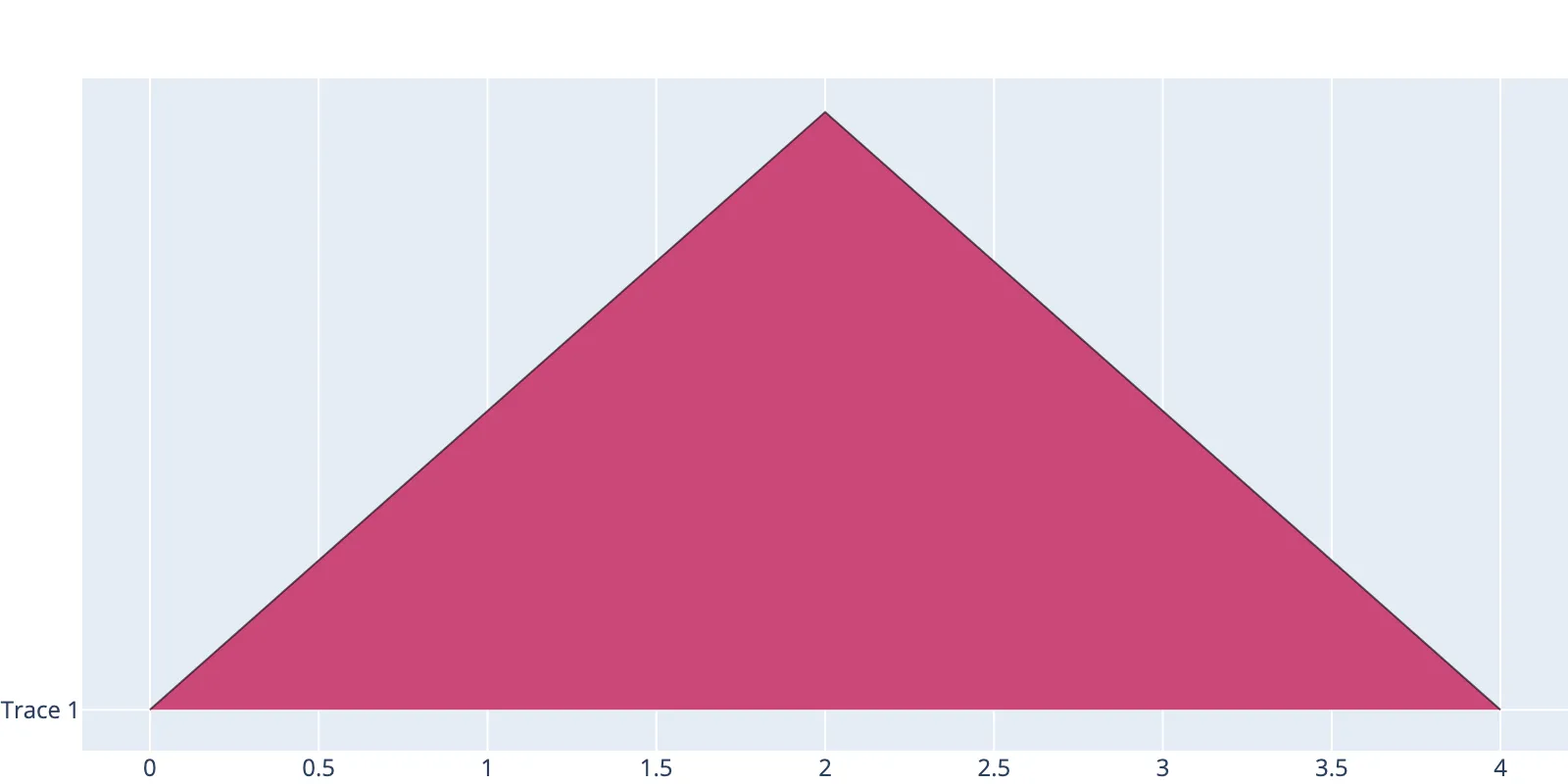
- ridgeplot._types.DensitiesRow¶
A
DensitiesRowrepresents a set ofDensityTraces that are to be plotted on a given row of a ridgeplot.These are equivalent:
DensitiesRowCollectionL2[XYCoordinate]Collection[Collection[Tuple[Numeric, Numeric]]]
Example
>>> densities_row = [ ... [(0, 0), (1, 1), (2, 0)], # Trace 1 ... [(1, 0), (2, 1), (3, 2), (4, 1)], # Trace 2 ... [(3, 0), (4, 1), (5, 2), (6, 1), (7, 0)], # Trace 3 ... ]
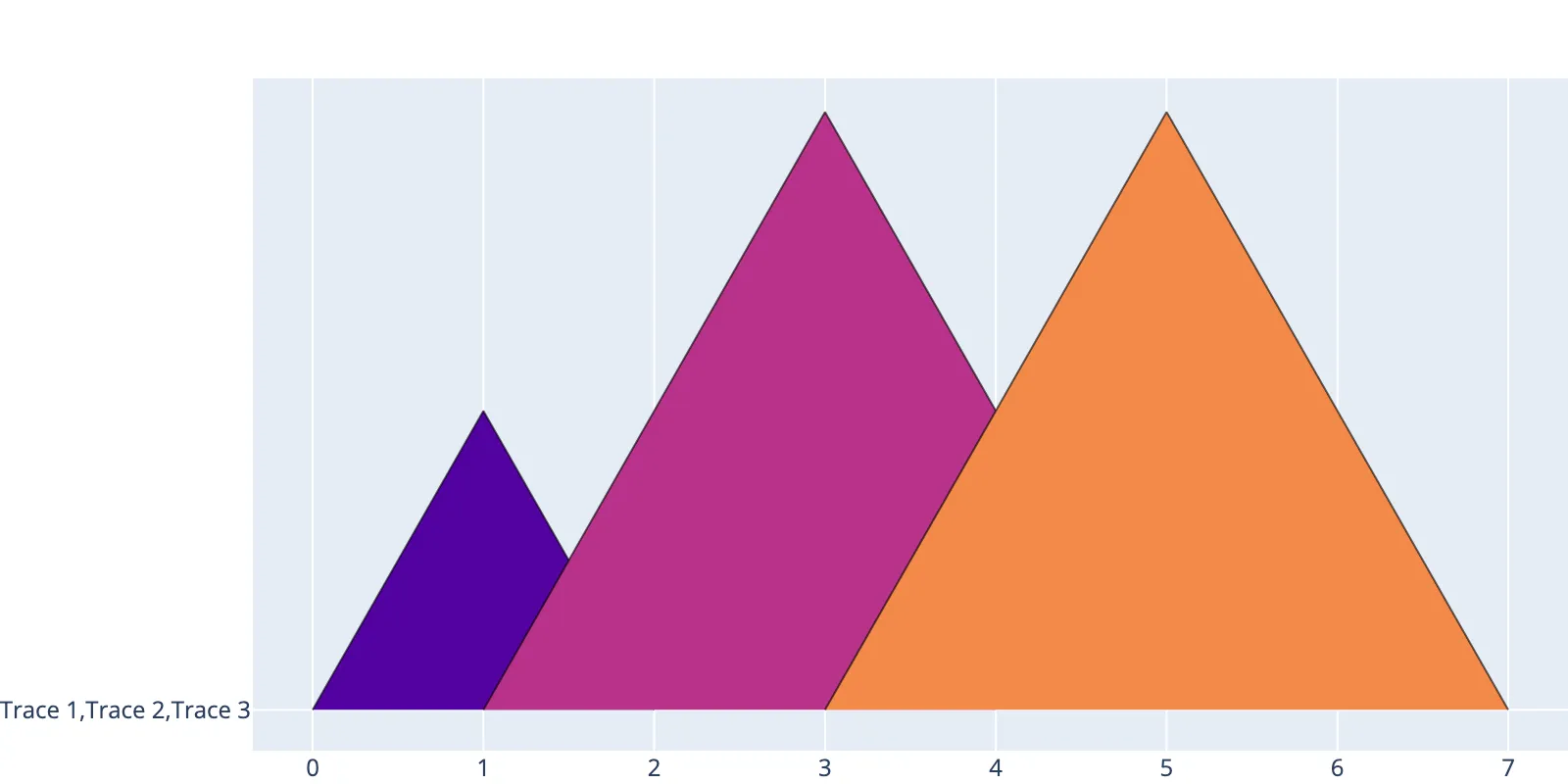
- ridgeplot._types.Densities¶
The
Densitiestype represents the entire collection of traces that are to be plotted on a ridgeplot.In a ridgeplot, several traces can be plotted on different rows. Each row is represented by a
DensitiesRowobject which, in turn, is a collection ofDensityTraces. Therefore, theDensitiestype is a collection ofDensitiesRows.These are equivalent:
DensitiesCollectionL1[DensitiesRow]CollectionL3[XYCoordinate]Collection[Collection[Collection[Tuple[Numeric, Numeric]]]]
Example
>>> densities = [ ... [ # Row 1 ... [(0, 0), (1, 1), (2, 0)], # Trace 1 ... [(1, 0), (2, 1), (3, 2), (4, 1)], # Trace 2 ... [(3, 0), (4, 1), (5, 2), (6, 1), (7, 0)], # Trace 3 ... ], ... [ # Row 2 ... [(-2, 0), (-1, 1), (0, 0)], # Trace 4 ... [(0, 0), (1, 1), (2, 1), (3, 0)], # Trace 5 ... ], ... ]
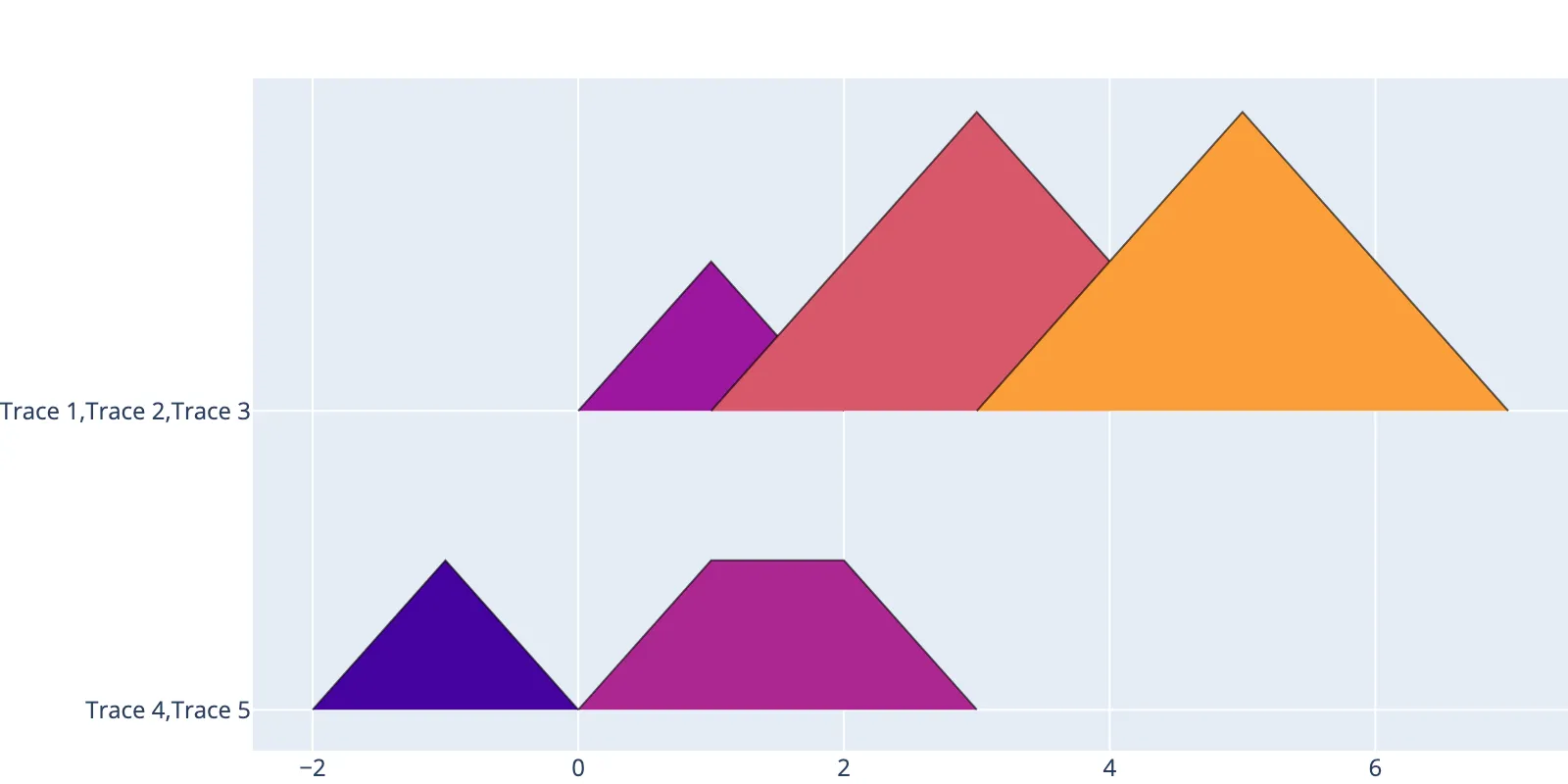
- ridgeplot._types.ShallowDensities¶
Shallow type for
Densitieswhere each row of the ridgeplot contains only a single trace.These are equivalent:
DensitiesCollectionL1[DensityTrace]CollectionL2[XYCoordinate]Collection[Collection[Tuple[Numeric, Numeric]]]
Example
>>> shallow_densities = [ ... [(0, 0), (1, 1), (2, 0)], # Trace 1 ... [(1, 0), (2, 1), (3, 0)], # Trace 2 ... [(2, 0), (3, 1), (4, 0)], # Trace 3 ... ]
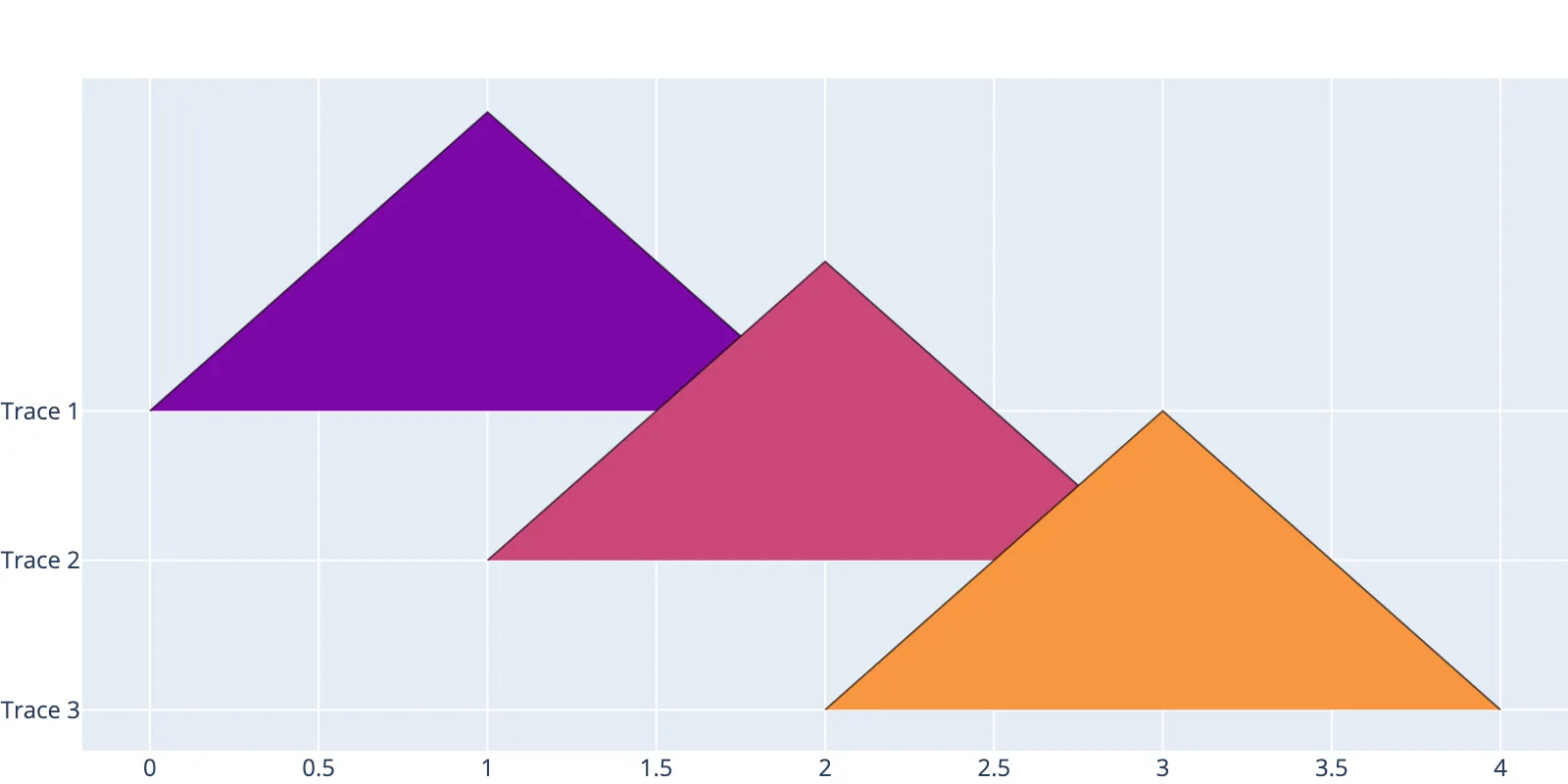
- ridgeplot._types.is_xy_coord(obj)[source]¶
Type guard for
XYCoordinate.
- ridgeplot._types.is_density_trace(obj)[source]¶
Type guard for
DensityTrace.
- ridgeplot._types.is_shallow_densities(obj)[source]¶
Type guard for
ShallowDensities.Examples
>>> is_shallow_densities("definitely not") False >>> is_shallow_densities([["also"], ["not"]]) False >>> deep_density = [ ... [ ... [(0, 0), (1, 1), (2, 2), (3, 3)], ... [(0, 0), (1, 1), (2, 2)], ... [(0, 0), (1, 1), (2, 2), (3, 3), (4, 4)], ... ], ... [ ... [(-2, 2), (-1, 1), (0, 1)], ... [(2, 2), (3, 1), (4, 1)], ... ], ... ] >>> is_shallow_densities(deep_density) False >>> shallow_density = [[(0, 0), (1, 1)], [(2, 2), (3, 1)]] >>> is_shallow_densities(shallow_density) True >>> shallow_samples = [[0, 1, 2], [2, 3, 4]] >>> is_shallow_densities(shallow_samples) False
- ridgeplot._types.is_densities(obj)[source]¶
Type guard for
Densities.Examples
>>> is_densities("definitely not") False >>> is_densities([["also"], ["not"]]) False >>> is_densities([[["still"], ["not"]], [["nope"]]]) False >>> shallow_density = [[(0, 0), (1, 1)], [(2, 2), (3, 1)]] >>> is_densities(shallow_density) False >>> deep_density = [ ... [ # Row 1 ... [(0, 0), (1, 1), (2, 0)], # Trace 1 ... [(1, 0), (2, 1), (3, 2), (4, 1)], # Trace 2 ... [(3, 0), (4, 1), (5, 2), (6, 1), (7, 0)], # Trace 3 ... ], ... [ # Row 2 ... [(-2, 0), (-1, 1), (0, 0)], # Trace 4 ... [(0, 0), (1, 1), (2, 1), (3, 0)], # Trace 5 ... ], ... ] >>> is_densities(deep_density) True
- ridgeplot._types.SamplesTrace¶
A
SamplesTraceis a collection of numeric values representing a set of samples from which aDensityTracecan be estimated via KDE.Example
>>> samples_trace = [0, 1, 1, 2, 2, 2, 3, 3, 4]
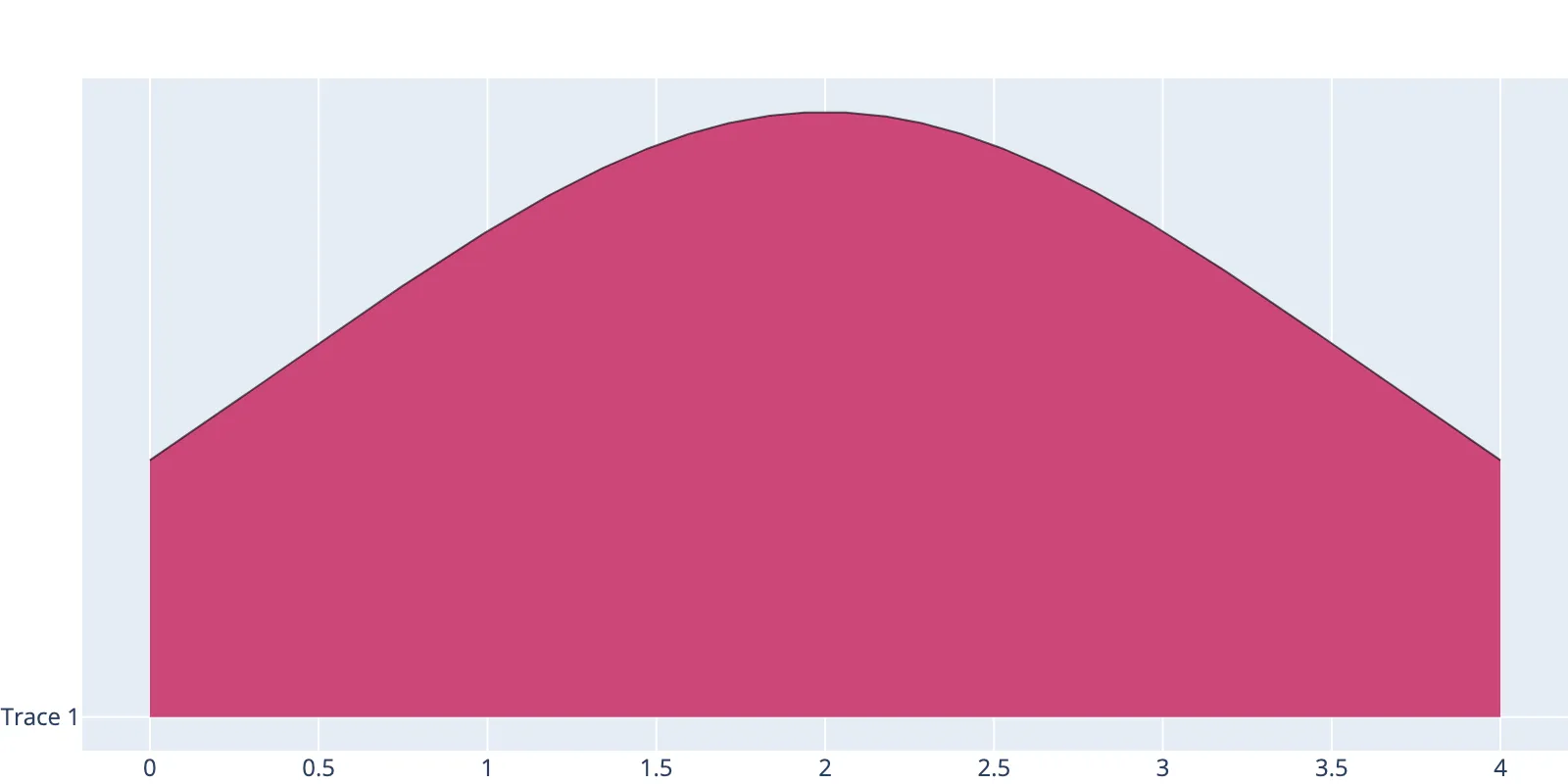
- ridgeplot._types.SamplesRow¶
A
SamplesRowrepresents a set ofSamplesTraces that are to be plotted on a given row of a ridgeplot.i.e. a
SamplesRowis a collection ofSamplesTraces and can be converted into aDensitiesRowby applying KDE to each trace.Example
>>> samples_row = [ ... [0, 1, 1, 2, 2, 2, 3, 3, 4], # Trace 1 ... [1, 2, 2, 3, 3, 3, 4, 4, 5], # Trace 2 ... ]
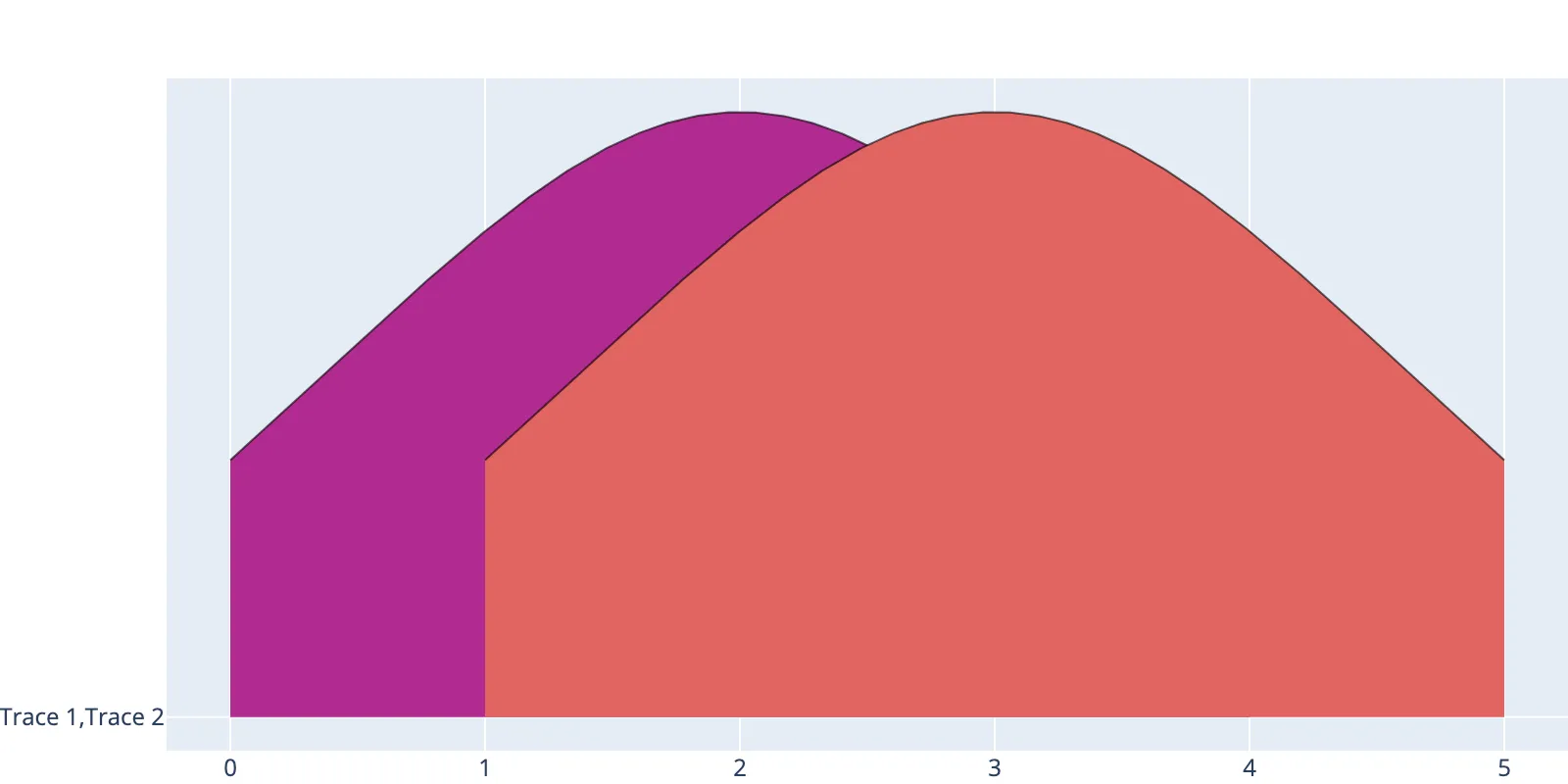
- ridgeplot._types.Samples¶
The
Samplestype represents the entire collection of samples that are to be plotted on a ridgeplot.It is a collection of
SamplesRowobjects. Each row is represented by aSamplesRowtype which, in turn, is a collection ofSamplesTraces which can be converted intoDensityTrace‘s by applying a kernel density estimation algorithm.Therefore, the
Samplestype can be converted into aDensitiestype by applying a kernel density estimation (KDE) algorithm to each trace.See
Densitiesfor more details.Example
>>> samples = [ ... [ # Row 1 ... [0, 1, 1, 2, 2, 2, 3, 3, 4], # Trace 1 ... [1, 2, 2, 3, 3, 3, 4, 4, 5], # Trace 2 ... ], ... [ # Row 2 ... [2, 3, 3, 4, 4, 4, 5, 5, 6], # Trace 3 ... [3, 4, 4, 5, 5, 5, 6, 6, 7], # Trace 4 ... ], ... ]
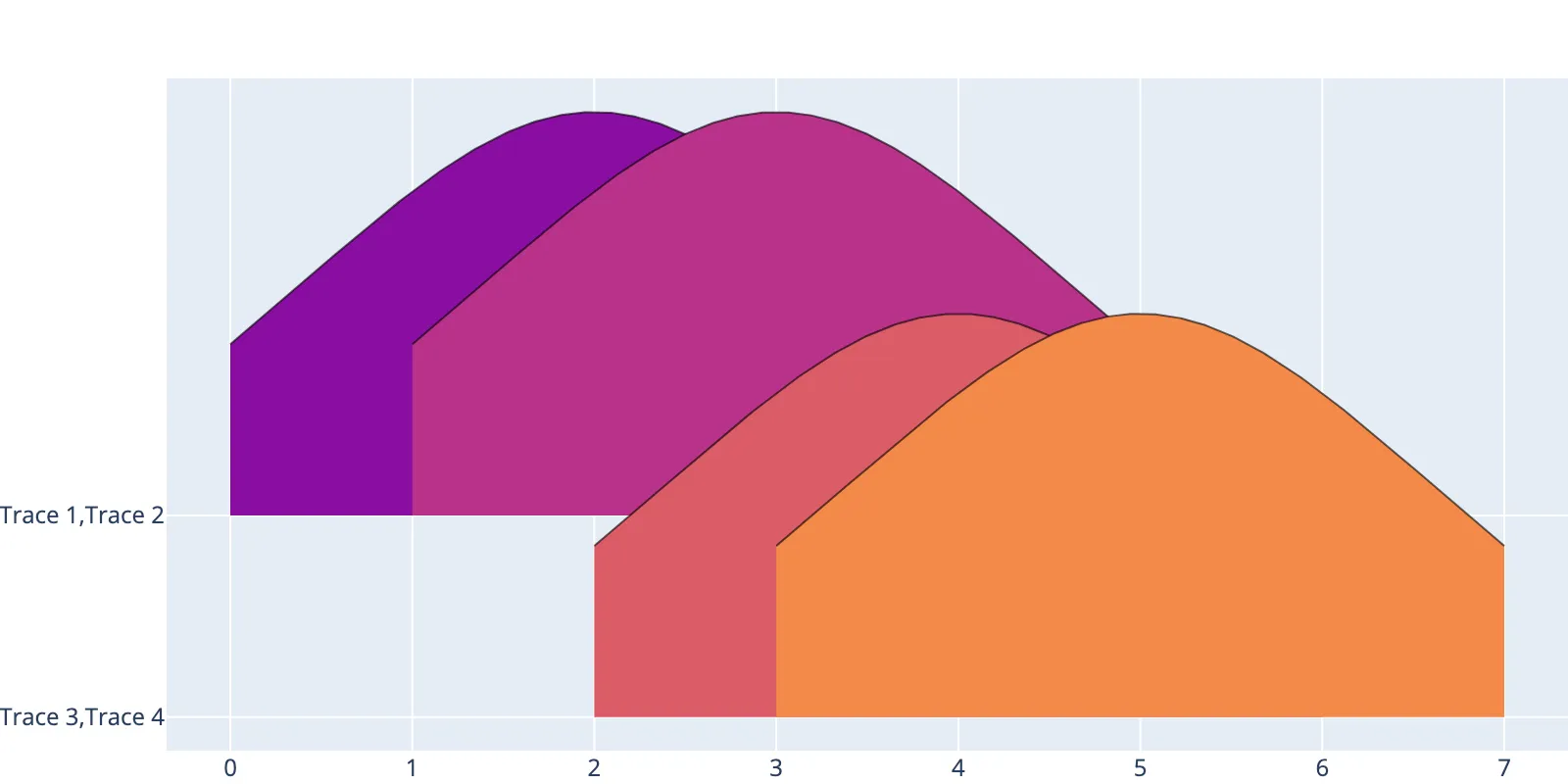
- ridgeplot._types.ShallowSamples¶
Shallow type for
Sampleswhere each row of the ridgeplot contains only a single trace.Example
>>> shallow_samples = [ ... [0, 1, 1, 2, 2, 2, 3, 3, 4], # Trace 1 ... [1, 2, 2, 3, 3, 3, 4, 4, 5], # Trace 2 ... ]
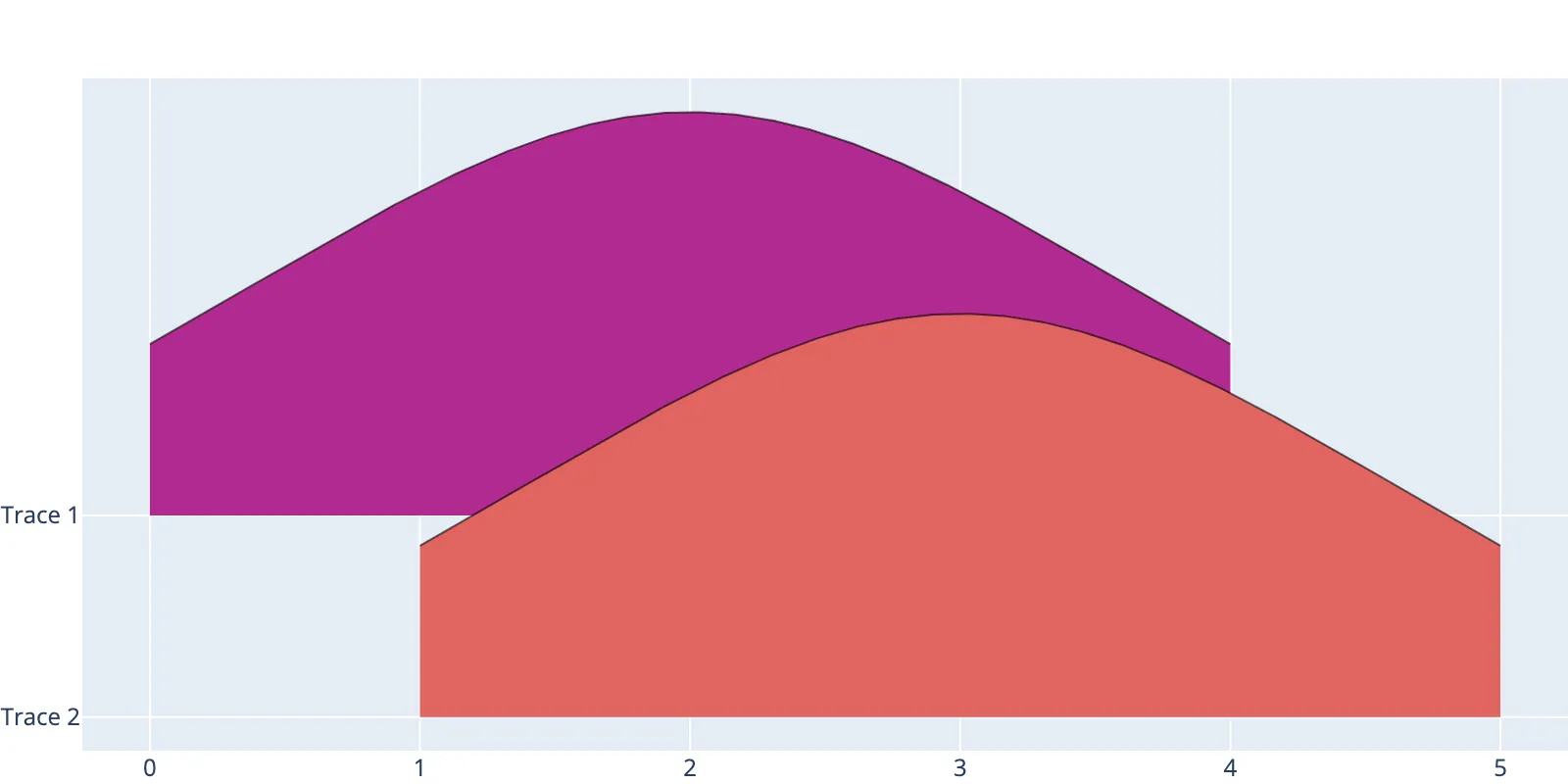
- ridgeplot._types.is_trace_samples(obj)[source]¶
Check if the given object is a
SamplesTracetype.
- ridgeplot._types.is_shallow_samples(obj)[source]¶
Type guard for
ShallowSamples.Examples
>>> is_shallow_samples("definitely not") False >>> is_shallow_samples([["also"], ["not"]]) False >>> deep_samples = [ ... [ ... [0, 0, 1, 1, 2, 2, 3, 3], ... [0, 0, 1, 1, 2, 2], ... [0, 0, 1, 1, 2, 2, 3, 3, 4, 4], ... ], ... [ ... [-2, 2, -1, 1, 0, 1], ... [2, 2, 3, 1, 4, 1], ... ], ... ] >>> is_shallow_samples(deep_samples) False >>> shallow_samples = [[0, 1, 2], [2, 3, 4]] >>> is_shallow_samples(shallow_samples) True >>> shallow_density = [[(0, 0), (1, 1)], [(2, 2), (3, 1)]] >>> is_shallow_samples(shallow_density) False
- ridgeplot._types.TraceType¶
The type of trace to draw in a ridgeplot. See
ridgeplot.ridgeplot.trace_typefor more information.alias of
Literal[‘area’, ‘bar’]
- ridgeplot._types.TraceTypesArray¶
A
TraceTypesArrayrepresents the types of traces in a ridgeplot.Example
>>> trace_types_array: TraceTypesArray = [ ... ["area", "bar", "area"], ... ["bar", "area"], ... ]
- ridgeplot._types.ShallowTraceTypesArray¶
Shallow type for
TraceTypesArray.Example
>>> trace_types_array: ShallowTraceTypesArray = ["area", "bar", "area"]
- ridgeplot._types.is_trace_type(obj)[source]¶
Type guard for
TraceType.Examples
>>> is_trace_type("area") True >>> is_trace_type("bar") True >>> is_trace_type("foo") False >>> is_trace_type(42) False
- ridgeplot._types.is_shallow_trace_types_array(obj)[source]¶
Type guard for
ShallowTraceTypesArray.Examples
>>> is_shallow_trace_types_array(["area", "bar", "area"]) True >>> is_shallow_trace_types_array(["area", "bar", "foo"]) False >>> is_shallow_trace_types_array([1, 2, 3]) False
- ridgeplot._types.is_trace_types_array(obj)[source]¶
Type guard for
TraceTypesArray.Examples
>>> is_trace_types_array([["area", "bar"], ["area", "bar"]]) True >>> is_trace_types_array([["area", "bar"], ["area", "foo"]]) False >>> is_trace_types_array([["area", "bar"], ["area", 42]]) False
- ridgeplot._types.LabelsArray¶
A
LabelsArrayrepresents the labels of traces in a ridgeplot.Example
>>> labels_array: LabelsArray = [ ... ["trace 1", "trace 2", "trace 3"], ... ["trace 4", "trace 5"], ... ]
- ridgeplot._types.ShallowLabelsArray¶
Shallow type for
LabelsArray.Example
>>> labels_array: ShallowLabelsArray = ["trace 1", "trace 2", "trace 3"]
- ridgeplot._types.SampleWeights: TypeAlias = collections.abc.Collection[int | numpy.integer[typing_extensions.Any] | float | numpy.floating[typing_extensions.Any]] | None¶
An array of KDE weights corresponding to each sample.
- ridgeplot._types.SampleWeightsArray¶
A
SampleWeightsArrayrepresents the weights of the datapoints in aSamplesarray. The shape of theSampleWeightsArrayarray should match the shape of the correspondingSamplesarray.
- ridgeplot._types.ShallowSampleWeightsArray¶
Shallow type for
SampleWeightsArray.
- ridgeplot._types.is_flat_str_collection(obj)[source]¶
Type guard for
CollectionL1[str].Note that this type-guard explicitly excludes the case where the object is a string itself (which can be considered a collection of string characters).
Examples
>>> is_flat_str_collection(["a", "b", "c"]) True >>> is_flat_str_collection("abc") False >>> is_flat_str_collection(["a", "b", 1]) False >>> is_flat_str_collection({"also", "a", "collection"}) True >>> is_flat_str_collection((1, 2)) False
- ridgeplot._types.is_flat_numeric_collection(obj)[source]¶
Type guard for
CollectionL1[Numeric].Examples
>>> is_flat_numeric_collection({1, 2, 3.14}) True >>> is_flat_numeric_collection((1, np.nan, np.inf)) True >>> is_flat_numeric_collection([3.14, np.float64(2.71), np.int64(42)]) True >>> is_flat_numeric_collection([1, 2, "3"]) False >>> is_flat_numeric_collection([1, 2, None]) False >>> is_flat_numeric_collection("definitely not") False
- ridgeplot._types.nest_shallow_collection(shallow_collection)[source]¶
Convert a shallow collection type into a deep collection type.
This function should really only be used in the
ridgeplot._ridgeplotmodule to normalise user input.Examples
>>> nest_shallow_collection([1, "2", {"a": 3}]) [[1], ['2'], [{'a': 3}]]